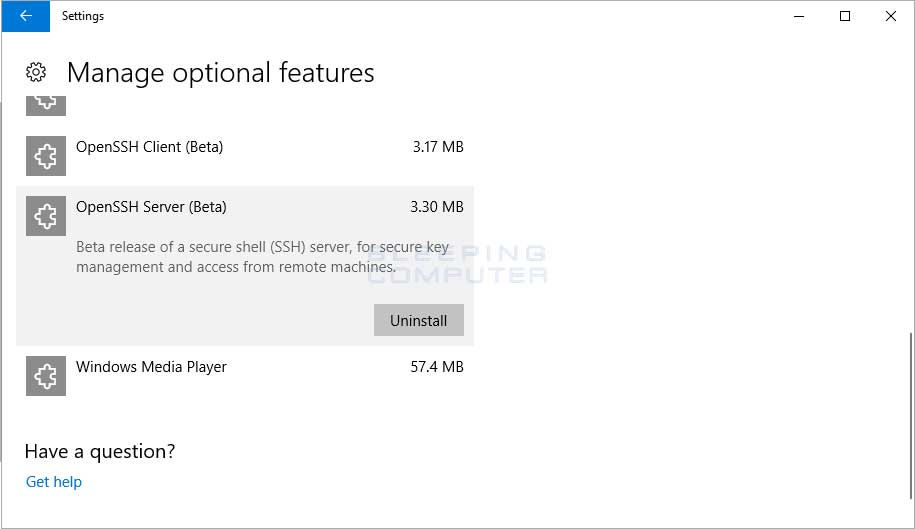Installing an OpenSSH server/client on a Windows 2016 server arms the user with a multi-function set of client/server utilities that facilitate a secure environment when logging into or transferring files to your windows server remotely. It also serves as a security management tool for your public/private key pairs. By default, the OpenSSH server logs to the AUTH facility of syslog, at the INFO level. If you want to record more information - such as failed login attempts - you should increase the logging level to VERBOSE. It's recommended to log more information if you're curious about malicious SSH traffic.
-->Applies to Windows Server 2019, Windows 10
OpenSSH is a connectivity tool for remote login that uses the SSH protocol. It encrypts all traffic between client and server to eliminate eavesdropping, connection hijacking, and other attacks.
OpenSSH can be used to connect Window 10 clients to Windows Server 2019. OpenSSH Client is available to install on Windows 10 build 1809 and later, while OpenSSH Server is available to install on Windows Server 2019 and later.
Important


If you downloaded OpenSSH from the GitHub repo at PowerShell/openssh-portable, follow the instructions listed there, not the ones in this article.
Install OpenSSH using Windows Settings
Download Openssh Client Windows 10
Both OpenSSH components can be installed using Windows Settings. OpenSSH Server is installed on Windows Server and OpenSSH Client is installed on Windows 10 devices.
Openssh-server Has No Installation Candidate
To install the OpenSSH components:
Open Settings, select Apps > Apps & Features, then select Optional Features.
Scan the list to see if the OpenSSH is already installed. If not, at the top of the page, select Add a feature, then:
- On Windows 10, find OpenSSH Client, then click Install
- On Windows Server 2019, find OpenSSH Server, then click Install
Once setup completes, return to Apps > Apps & Features and Optional Features and you should see OpenSSH listed.
Note
Installing OpenSSH Server will create and enable a firewall rule named OpenSSH-Server-In-TCP. This allows inbound SSH traffic on port 22. If this rule is not enabled and this port is not open, connections will be refused or reset.
Install OpenSSH using PowerShell
To install OpenSSH using PowerShell, run PowerShell as an Administrator.To make sure that OpenSSH is available, run the following cmdlet:
This should return the following output:
Then, install the server or client components as needed:
Serial communication with labview tutorial download. Both of these should return the following output:
Start and configure SSH Server
To start and configure OpenSSH server for initial use, open PowerShell as an administrator, then run the following commands to start the SSHD service:
Connect to SSH Server
Once installed, you can connect to OpenSSH Server from a Windows 10 device with the SSH client installed using PowerShell as follows. Isohunt primavera 6 torrent. Be sure to run PowerShell as an administrator:
Once connected, you get a message similar to the following:
Selecting yes adds that server to the list of known ssh hosts on your Windows client.
You are prompted for the password at this point. As a security precaution, your password will not be displayed as you type.
Once connected, you will see the Windows command shell prompt:
Uninstall OpenSSH using Windows Settings
To uninstall OpenSSH using Windows Settings:


- Open Settings, then go to Apps > Apps & Features.
- Go to Optional Features.
- In the list, select OpenSSH Client or OpenSSH Server.
- Select Uninstall.
Uninstall OpenSSH using PowerShell
To uninstall the OpenSSH components using PowerShell, use the following commands:
Minecraft 1.12.2 maps. You may need to restart Windows afterwards if the service was in use at the time it was uninstalled.
-->OpenSSH is the open-source version of the Secure Shell (SSH) tools used by administrators of Linux and other non-Windows for cross-platform management of remote systems.OpenSSH has been added to Windows as of autumn 2018, and is included in Windows 10 and Windows Server 2019.
SSH is based on a client-server architecture where the system the user is working on is the client and the remote system being managed is the server.OpenSSH includes a range of components and tools designed to provide a secure and straightforward approach to remote system administration, including:

- sshd.exe, which is the SSH server component that must be running on the system being managed remotely
- ssh.exe, which is the SSH client component that runs on the user's local system
- ssh-keygen.exe generates, manages and converts authentication keys for SSH
- ssh-agent.exe stores private keys used for public key authentication
- ssh-add.exe adds private keys to the list allowed by the server
- ssh-keyscan.exe aids in collecting the public SSH host keys from a number of hosts
- sftp.exe is the service that provides the Secure File Transfer Protocol, and runs over SSH
- scp.exe is a file copy utility that runs on SSH
Documentation in this section focuses on how OpenSSH is used on Windows, including installation, and Windows-specific configuration and use cases. Here are the topics:
Openssh Server Wsl
Additional detailed documentation for common OpenSSH features is available online at OpenSSH.com.
Openssh Server Ubuntu 20.04
The master OpenSSH open source project is managed by developers at the OpenBSD Project.The Microsoft fork of this project is in GitHub.Feedback on Windows OpenSSH is welcomed and can be provided by creating GitHub issues in our OpenSSH GitHub repo.
